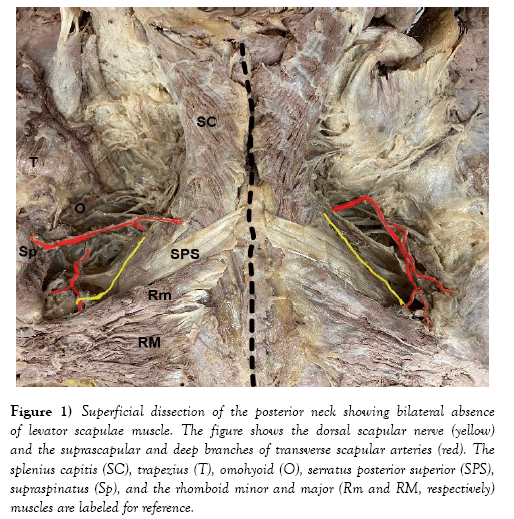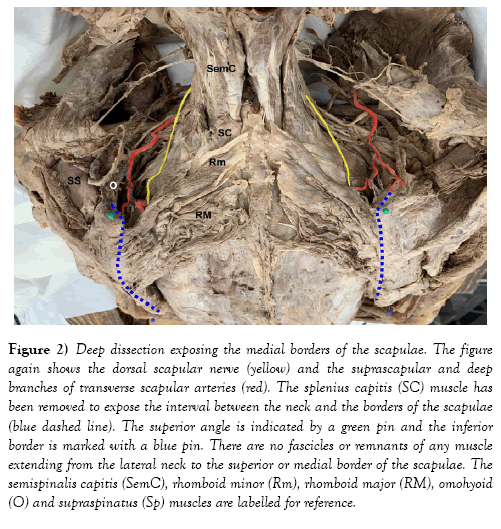Congenital bilateral absence of levator scapulae muscles: A case report
Received: 23-Aug-2019 Accepted Date: Dec 07, 2019; Published: 16-Dec-2019, DOI: 10.37532/1308-4038.20.13.66
Citation: Klinesmith S, Kulesza R. Congenital bilateral absence of levator scapulae muscles: A case report. Int J Anat Var. 2019;13(1): 66-67.
This open-access article is distributed under the terms of the Creative Commons Attribution Non-Commercial License (CC BY-NC) (http://creativecommons.org/licenses/by-nc/4.0/), which permits reuse, distribution and reproduction of the article, provided that the original work is properly cited and the reuse is restricted to noncommercial purposes. For commercial reuse, contact reprints@pulsus.com
Abstract
The levator scapulae muscle is a thin, four-bellied muscle spanning the posterior neck and scapular region. Previous case reports have documented highly variable origins and insertions of this muscle, with the most common variations being additional slips and bellies. However, there are no previous reports demonstrating congenital absence of this muscle. Herein, we report dissection of a cadaveric specimen where the levator scapulae muscle was absent bilaterally. While bilateral congenital absence of the levator scapular appears to be an extremely rare occurrence, the absence of this muscle might put neurovascular bundles in the posterior neck and scapular region at increased risk from penetrating trauma or surgical procedures.
Keywords
levator scapulae; Anatomical variation; Congenital absence
Introduction
The levator scapulae muscle (LSM) is a bilaterally symmetric muscle that originates from the transverse processes of the first through fourth cervical vertebrae and inserts onto the superior angle of medial border of the scapula [1]. The LSM is in contact anteriorly with the middle scalene muscle, laterally with the sternocleidomastoid and trapezius muscles, posteriorly with the splenius cervicis muscle and medially with the posterior scalene muscle [2]. The LSM is innervated by the dorsal scapular nerve, as well as the anterior rami of the C3 and C4 spinal nerves. The primary function of the levator scapulae is elevating the scapula [1], however it has been suggested that it also assists in downward rotation of the scapula [2]. While it is known that skeletal muscle develops from somites formed during week 7 of gestation [3], little is known regarding the exact origin and development of the LSM. It appears that the LSM develops from the dorsal muscle mass of the upper limb bud [4]. Regardless, it is likely it is derived from 3 or 4 somites, as it is innervated by multiple spinal levels. This article reported a case of bilateral absence of levator scapulae muscle.
Case Report
A previously undocumented variation was found while performing routine cadaveric dissection of a 74-year-old male who died of natural causes in the Gross Anatomy Laboratory at Lake Erie College of Osteopathic Medicine during the summer of 2019. During the dissection, both trapezius muscles were reflected superiorly from the midline and scapular spine attachments. Examination of the posterior neck, deep to the trapezius (T) muscle revealed omohyoid (O), supraspinatus (Sp), splenius capitis (SC), serratus posterior superior (SPS) and the rhomboid minor and major (Rm and RM, respectively) muscles. However, the LSMs were absent bilaterally. Further dissection revealed the dorsal scapular nerves, which could be traced from the middle scalene muscles to the rhomboid minor muscles bilaterally. The suprascapular and the deep branch of transverse scapular arteries were also identified and preserved bilaterally (Figures 1 and 2).
Figure 1: Superficial dissection of the posterior neck showing bilateral absence of levator scapulae muscle. The figure shows the dorsal scapular nerve (yellow) and the suprascapular and deep branches of transverse scapular arteries (red). The splenius capitis (SC), trapezius (T), omohyoid (O), serratus posterior superior (SPS), supraspinatus (Sp), and the rhomboid minor and major (Rm and RM, respectively) muscles are labeled for reference.
Figure 2: Deep dissection exposing the medial borders of the scapulae. The figure again shows the dorsal scapular nerve (yellow) and the suprascapular and deep branches of transverse scapular arteries (red). The splenius capitis (SC) muscle has been removed to expose the interval between the neck and the borders of the scapulae (blue dashed line). The superior angle is indicated by a green pin and the inferior border is marked with a blue pin. There are no fascicles or remnants of any muscle extending from the lateral neck to the superior or medial border of the scapulae. The semispinalis capitis (SemC), rhomboid minor (Rm), rhomboid major (RM), omohyoid (O) and supraspinatus (Sp) muscles are labelled for reference.
Discussion
Numerous case reports have described variation of origin and insertion of the LSM. More common variations include an additional muscle belly originating from the mastoid process and inserting with the main muscle belly at the scapula [5] with additional attachments to the ligamentum nuchae, rhomboid major muscle, and serratus posterior superior muscle [6].
Other variations have been documented including additional or the absence of slips originating from variable transverse processes, slips attached to the trapezius or splenius capitis muscles or scapular spine, and an additional slip underlying the main muscle belly [7]. An MRI study of 37 participants observed many variable attachments including onto the serratus anterior muscle, serratus posterior superior muscle, and the ribs, however all participants presented with LSMs bilaterally [8].
Although wide variation of the LSM has been documented, a bilateral congenital absence of the muscle appears to be an extremely rare occurrence without any previous case reports to date. Bilateral absence of the LSMs presents a few important clinical implications. First, as the primary action of the LSM is elevation of the scapulae [1], absence of this muscle must be considered when treating those with impaired motion or weakness of the shoulder. Second, the scapulohumeral reflex of Shimizu used to evaluate the function of spinal levels C1 to C3 may appear decreased as the LSM is one of three muscle groups involved in the reflex [9]. Third, myofascial pain syndrome is a common cause of musculoskeletal pain of the neck and shoulder region. Standard treatment includes manual pressure release and analgesic injections at the appropriate myofascial trigger points [10,11]. Physicians must be aware of the possibility of the absence of this muscle, and exposure of the dorsal scapular nerve and underlying blood supply, when treating shoulder and neck conditions to prevent injury or paralysis of the rhomboid muscle group [1]. Finally, the LSM is necessary in the Eden- Lange method, a surgical treatment of spinal accessory nerve injury where the trapezius muscle is paralyzed. During this procedure, both the LSM and rhomboid group are removed from their respective insertions on the scapula and transferred to secondary insertion points on the scapula in an attempt to restore mobility of the shoulder [12]. Without the LSM, this procedure is not an option for patients affected by trapezius muscle paralysis.
Conclusion
This case report documents the absence of the LSM bilaterally. No previous reports have been found documenting this occurrence. The LSM is one of the primary elevators of the scapulae and would result in significant shoulder weakness when absent. Physicians should be aware of the possibility of this absence to avoid injury to the underlying nerve and blood supply when treating myofascial pain syndrome and other shoulder conditions.
Acknowledgements
The authors would like to thank the donor and his family for their generous contribution to medical education
REFERENCES
- Drake RL, Vogl AW, Mitchell AWM. Gray’s Anatomy for Students. 3rd Edtn, Philadelphia, Elsevier. 2015;89-90.
- Rockwood CA Jr, Matsen FA III, eds. The Shoulder. 4th Edtn, Vol. 1, Philadelphia, Saunders. 2009;55-56.
- Sadler TW. Medical Embryology. 12th Edtn, Baltimore, Lippincott Williams & Wilkins. 2012;146-8.
- Schoenwolf GC, Bleyl SB, Brauer PR, et al. Larsen’s Human Embryology. 5th Edtn, Philadelphia, Elsevier. 2015;192.
- Chotai PN, Loukas M, Tubbs RS. Unusual origin of the levator scapulae muscle from the mastoid process. Surg Radiol Anat. 2015;37:1277-81.
- Loukas M, Louis RG Jr, Merbs W. A case of atypical insertion of the levator scapulae. Folia Morphol. 2006;65:232-5.
- Bergman RA, Afifi AK, Miyauchi R. Illustrated encyclopaedia of human anatomic variation. Anatomy Atlases. 2019.
- Au J, Webb A, Buirski G, et al. Anatomic variations of levator scapulae in a normal cohort: an MRI study. Surg Radiol Anat. 2017;39:337-43.
- Shimizu T, Shimada H, Shirakura K. Scapulohumeral reflex (Shimizu). Its clinical signficance and testing maneuver. Spine (Phila Pa 1976). 1993;18:2182-90.
- Pecos-Martin D, Ponce-Castro MJ, Jiménez-Rejano JJ, et al. Immediate effects of variable durations of pressure release technique on latent myofascial trigger points of the levator scapulae: A double-blinded randomized clinical trial. Acupunct Med. 2019;37:141-50.
- Parthasarathy S, Sundar S, Mishra G. Assessment of predisposing factors in myofascial pain syndrome and the analgesic effect of trigger point injections: A primary therapeutic interventional clinical trial. Indian J Anaesth. 2019;63:300-3.
- Amroodi MN, Salariyeh M. Single-incision Eden-Lange procedure in trapezius muscle paralysis: A report of 11 cases. Acta Orthop Traumatol Turc. 2018;52:115-9.








